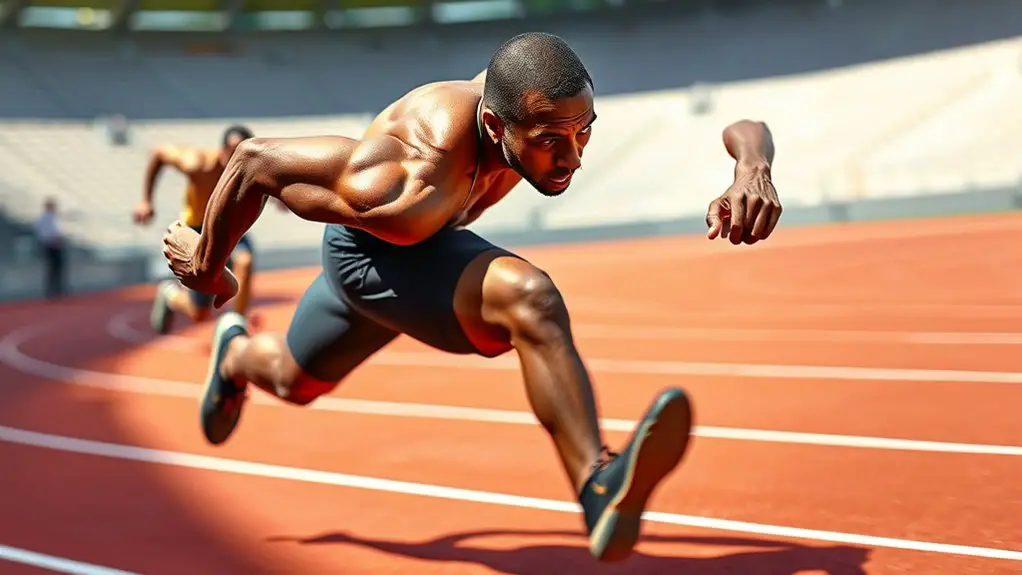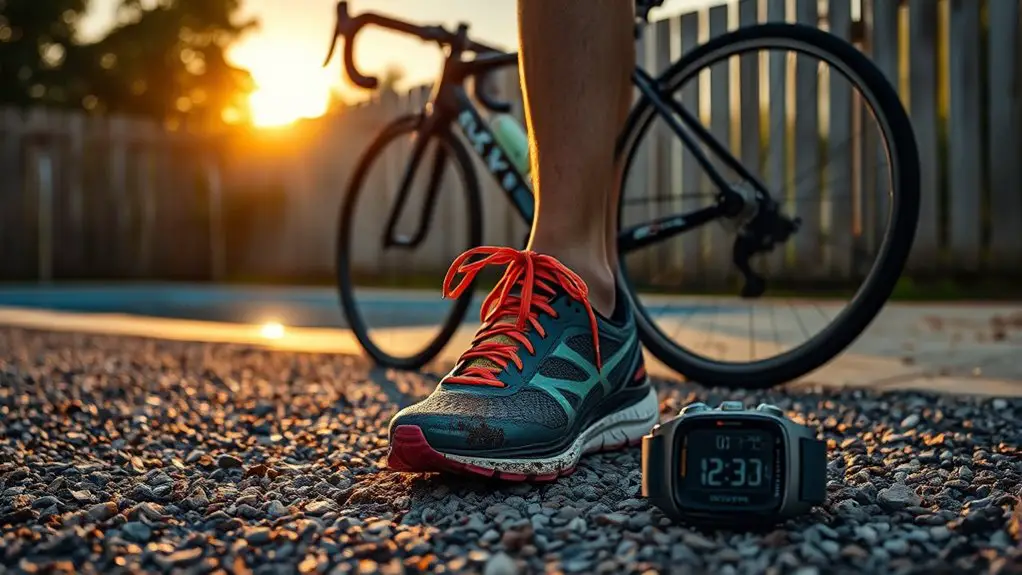To build endurance for long-distance rowing, focus on structured training plans that include long steady-state rows and interval training to boost stamina. Incorporate strength training to enhance your core stability and reduce injury risk. Don't forget proper nutrition and hydration; eat nutrient-dense pre-row meals, stay hydrated, and replenish after workouts. Finally, cultivate mental resilience with visualization and positive self-talk. There's much more to explore about optimizing your training and recovery strategies.
Understanding Endurance in Rowing
Endurance in rowing isn't just about physical strength; it's a mental game too. You need to understand how endurance physiology works alongside rowing mechanics to truly excel. Your body relies on aerobic capacity, which is the ability to sustain effort over time. This means your heart and lungs must work harmoniously to deliver oxygen to your muscles efficiently.
As you row, focus on your technique. Proper rowing mechanics can enhance your efficiency, allowing you to maintain speed with less effort. Think about your stroke—how you engage your core and legs, and how you maintain a steady rhythm. This coordination reduces fatigue, letting you push through longer distances with a clearer mind.
Ultimately, embracing the mental aspect of endurance will empower you to release your potential. The freedom you seek in long-distance rowing starts with understanding your body's capabilities and mastering the art of efficient rowing. Additionally, improving your muscle efficiency can significantly enhance your performance and endurance during long sessions on the water.
The Importance of a Structured Training Plan
A structured training plan is essential for your success in long-distance rowing. By setting clear goals, utilizing a periodization approach, and effectively monitoring your progress, you can maximize your endurance and performance. Let's explore how these elements work together to enhance your training experience.
Goal Setting Strategies
Setting clear and achievable goals is essential for any long-distance rowing journey. You need a roadmap that keeps you motivated and focused on your freedom to explore the water. Start by using goal visualization techniques to picture yourself reaching your desired distance or performance level. Break that big dream into short-term milestones that serve as stepping stones along the way. These milestones not only make your goals more attainable but also help you celebrate progress, which fuels your passion. When you achieve each milestone, you'll feel empowered, reinforcing your commitment to the journey ahead. Embrace the process, adjust as needed, and let your goals guide you toward the exhilarating freedom of long-distance rowing.
Periodization Training Approach
Achieving your long-distance rowing goals requires more than just motivation; it demands a well-structured training plan. A periodization training approach can help you reach your peak performance while keeping things fresh and exciting. By breaking your training into distinct cycles, you can focus on specific goals during each phase. Here's how to structure it:
- Preparation Phase: Build a solid base with endurance and strength.
- Base Phase: Increase your mileage gradually, focusing on technique and stamina.
- Build Phase: Introduce intensity through interval training and race simulations.
- Peak Phase: Taper your training to allow your body to recover and be ready for competition.
With these periodization cycles, you'll find freedom in your training while steadily progressing toward your long-distance rowing ambitions.
Monitoring Progress Effectively
While you might feel motivated to row long distances, effectively monitoring your progress is essential to reaching your goals. A structured training plan allows you to enjoy the freedom of rowing while ensuring you're on the right track. By incorporating progress tracking tools, you can see how far you've come and what areas need improvement. Focus on performance metrics like time, distance, and stroke rate to gain insights into your endurance levels. This data not only keeps you accountable but also helps you adjust your training as needed. Embrace the journey, but don't forget to check in on those numbers. They're your compass guiding you toward greater achievements on the water.
Incorporating Long Steady-State Rows
To build endurance for long-distance rowing, incorporating long steady-state rows into your training regimen is essential. These rows help you develop a solid rowing rhythm and maximize the steady state benefits. Here's how to make the most of your steady-state workouts:
Incorporating long steady-state rows is crucial for building endurance and mastering your rowing rhythm.
- Choose the Right Distance: Start with at least 60 minutes, gradually increasing as you build endurance.
- Focus on Pacing Techniques: Maintain a consistent pace to prevent fatigue and improve efficiency.
- Monitor Your Heart Rate: Keep it within a steady range to optimize your endurance workouts.
- Stay Relaxed: Embrace the flow; a relaxed body enhances your rowing rhythm and keeps you focused. Additionally, incorporating high-intensity interval training can effectively boost your aerobic capacity, complementing your long steady-state rows.
Interval Training for Improved Stamina
Incorporating interval training into your rowing routine can greatly boost your stamina and performance. By focusing on high intensity intervals, you can push your limits and enhance your cardiovascular fitness. Start with short bursts of intense rowing, followed by rest periods to recover. This approach not only builds endurance but also teaches your body to adapt to varying levels of exertion.
Experiment with pacing strategies during these intervals. For example, try a 1:1 ratio, where you row hard for one minute and rest for one minute. As you progress, you can adjust these ratios based on how you feel. This flexibility keeps your workouts engaging and can lead to significant improvements. Additionally, this method emphasizes the rhythm of intensity and recovery, allowing you to explore your limits while training effectively.
Strength Training for Rowing Endurance
To build your rowing endurance, incorporating strength training is essential. You'll want to focus on core stability exercises, resistance training techniques, and functional strength movements. These workouts not only enhance your power on the water but also improve your overall stability and efficiency. Additionally, functional strength training can significantly reduce your risk of injury while boosting your athletic performance.
Core Stability Exercises
While building endurance for long-distance rowing, it's vital to focus on core stability exercises that enhance strength and control. A strong core not only improves your rowing efficiency but also keeps you injury-free, allowing for that exhilarating sense of freedom on the water. Here are four effective core engagement exercises to include in your stability training routine:
- Planks – Hold a plank position to strengthen your entire core.
- Russian Twists – Twist your torso to engage obliques, significant for rowing rotation.
- Bird-Dogs – Balance on hands and knees while extending opposite limbs to build stability.
- Side Leg Raises – Strengthen your hip abductors, supporting better posture while rowing.
Incorporating these exercises will enhance your endurance and overall performance on the water.
Resistance Training Techniques
As you aim to enhance your endurance for long-distance rowing, resistance training techniques play an essential role in building the necessary strength and power. Incorporating strength training, like weight lifting and resistance bands, will help develop muscle endurance and power development. Focus on compound movements and progressive overload to maximize your results.
Here's a quick guide to effective resistance exercises:
| Exercise Type | Example |
|---|---|
| Resistance Bands | Band Squats |
| Weight Lifting | Deadlifts |
| Exercise Variations | Single-Arm Rows |
| Functional Training | Kettlebell Swings |
Functional Strength Movements
Incorporating functional strength movements into your training routine can greatly enhance your endurance for long-distance rowing. By focusing on functional movement patterns, you'll build strength that translates directly to the water, giving you the freedom to row longer and stronger. Here are four essential exercises to integrate into your workouts:
- Squats: Develop leg power for powerful strokes.
- Deadlifts: Strengthen your posterior chain for better posture and drive.
- Planks: Build core stability to maintain form over long distances.
- Pull-ups: Enhance upper body strength essential for rowing endurance.
These strength training fundamentals not only boost your performance but also help prevent injuries, letting you enjoy the freedom of the open water longer.
Nutrition Strategies for Endurance Athletes
To fuel your body effectively for long-distance rowing, it's essential to focus on proper nutrition strategies that support endurance. Start with carbohydrate timing; consuming carbs before your row gives you the energy you need. For your pre-row meals, opt for foods with high nutrient density, like whole grains and fruits. During your workout, snack strategies—like energy gels or bananas—can help maintain your energy levels.
Post-row recovery is just as important. Aim for a balanced meal with adequate protein intake to repair muscles and replenish glycogen stores. Don't forget about electrolyte balance; including sodium and potassium-rich foods in your meal planning guarantees you're maintaining bodily functions. Hydration timing also matters; drink water throughout the day and especially before and after rowing. Proper hydration is crucial for endurance performance, making mindful food choices will enhance your performance and give you the freedom to enjoy the sport you love.
Hydration: Staying Fueled on the Water
When you're out on the water for long distances, staying hydrated is just as essential as your nutrition. Proper hydration helps maintain your energy levels and can prevent fatigue. Let's explore effective hydration strategies specifically designed for rowers like you. It's important to understand the signs of dehydration, as recognizing them can help you take action before fatigue sets in.
Importance of Hydration
Although it might be easy to overlook hydration during long-distance rowing, staying properly fueled with water is essential for maintaining endurance and performance. Dehydration can seriously impact your stamina and focus, so make sure you're aware of your hydration sources. Here are four key reasons why proper hydration matters:
- Maintains Electrolyte Balance: Keeping your electrolytes in check helps prevent cramps and fatigue.
- Enhances Performance: Staying hydrated boosts your energy levels, allowing you to row longer and harder.
- Aids Recovery: Proper hydration speeds up recovery, keeping you ready for your next adventure on the water.
- Improves Mental Clarity: Staying focused and sharp enhances your decision-making while steering through the waves.
Embrace the freedom of the water, and prioritize hydration!
Hydration Strategies for Rowers
As you commence those long-distance rowing sessions, knowing how to stay hydrated can make all the difference in your performance and endurance. Focus on hydration timing, aiming to drink water or sports drinks every 15-20 minutes. This helps maintain your electrolyte balance and keeps your energy levels up. Here's a simple guide to hydration sources and water intake:
| Time | Hydration Source | Quantity |
|---|---|---|
| Pre-rowing | Water/Sports Drink | 500ml |
| During rowing | Electrolyte Drink | 150-200ml per hour |
| Post-rowing | Water | 750ml |
| Daily | Water/Sports Drink | 2-3 liters |
| Recovery | Electrolyte Drink | As needed |
Stay free to explore what works best for you, and remember: hydration is key for long-distance success!
Mental Techniques to Enhance Focus and Resilience
Focus and resilience are essential for success in long-distance rowing, where the mental game often rivals the physical demands. To enhance your mental strength, consider these techniques:
Mastering the mental game is crucial for long-distance rowing success, complementing the physical challenges faced on the water.
- Visualization Techniques: Picture yourself powering through each stroke, feeling the rhythm of the water. This mental imagery helps reinforce your goals and boosts confidence.
- Mindfulness Practices: Stay present during your rowing sessions. Tune into your breath and the sounds around you, which can help you maintain focus and reduce anxiety.
- Positive Self-Talk: Replace negative thoughts with affirmations. Remind yourself of your capabilities to cultivate a resilient mindset.
- Goal Setting: Set tangible, achievable goals for each session. Breaking down your long-distance journey into smaller milestones keeps you motivated and engaged. Additionally, incorporating mindfulness practices into your routine can enhance focus and reduce anxiety, further improving your endurance.
Recovery: The Key to Sustained Performance
While pushing your limits on the water is vital for improving your rowing endurance, effective recovery is just as important for sustained performance. You can't just row hard; you need to take the time to let your body bounce back. Embrace recovery techniques like foam rolling, stretching, and proper hydration. These not only ease muscle soreness but also enhance your overall performance.
Active recovery is a game changer, too. Think of low-intensity activities, like walking or light cycling, as a way to keep your blood flowing without taxing your body. This approach helps repair muscles while keeping you engaged in movement. Don't underestimate the power of rest days, either; they're essential for mental rejuvenation and physical repair. Rest days contribute to a vibrant, sustainable fitness experience and you'll find your endurance on the water improves considerably, allowing you to row longer and with greater freedom.
Setting Realistic Goals and Tracking Progress
Setting realistic goals is essential, especially when you're aiming to build endurance for long-distance rowing. It helps you stay motivated and focused on your journey toward freedom on the water. Here are four steps to guide you:
Setting realistic goals is crucial for enhancing your endurance in long-distance rowing, keeping you motivated on your journey.
- Define Your Goals: Set specific, measurable, achievable, relevant, and time-bound (SMART) goals that resonate with your rowing aspirations.
- Practice Goal Visualization: Picture yourself achieving those goals. This mental imagery can boost your confidence and commitment.
- Create a Training Plan: Outline a structured plan that progressively increases your rowing distance and intensity, ensuring you're not pushing too hard, too fast.
- Engage in Progress Journaling: Document your training sessions and feelings. This reflection helps you track improvements and adjust your goals as needed.
Frequently Asked Questions
What Gear Do I Need for Long-Distance Rowing?
When you're gearing up for long-distance rowing, you'll want to focus on essential equipment that enhances your experience. A comfortable rowing seat and a sturdy boat are key, but don't forget your rowing accessories like a good life jacket, oar grips, and a waterproof bag for your belongings. Sun protection and proper footwear are also vital. With the right gear, you can enjoy the freedom of the open water without worry!
How Often Should I Change My Rowing Technique?
When you're rowing, your technique's vital for performance. You should assess your technique regularly—maybe every few weeks or after significant training boosts. Look for technique adjustments that enhance your stroke efficiency. Experiment with minor tweaks, and don't hesitate to make changes if something feels off. Remember, freedom in movement comes from a solid foundation, so keep refining your approach to access your full potential on the water.
Can I Row Solo or Do I Need a Team?
You can definitely row solo if you prefer that freedom! Solo rowing lets you set your own pace and enjoy the tranquility of the water. However, team dynamics can enhance your experience, offering camaraderie and motivation. If you thrive in a social environment, joining a team can be rewarding. Ultimately, it's about what suits you best—whether you cherish the independence of solo rowing or the collaboration of a team.
What Are the Best Weather Conditions for Long-Distance Rowing?
Picture the sun kissing your skin as you glide over glassy waters; that's the magic of ideal weather for long-distance rowing. You'll want temperatures between 60°F and 75°F, where the warmth fuels your spirit without draining your energy. Calm winds are your best friend; gentle breezes can guide you, but strong gusts might feel like a battle. Embrace those perfect conditions, and let the waves carry you towards freedom.
How Can I Prevent Blisters While Rowing?
To prevent blisters while rowing, you'll want to focus on blister prevention techniques. Start by ensuring your grip's comfortable; use padded gloves or tape to create a barrier against friction. Experiment with different grip techniques to find what feels best for you. Keeping your hands dry and taking breaks to stretch can also help. With a little care, you can enjoy the freedom of rowing without the pain of blisters holding you back!




